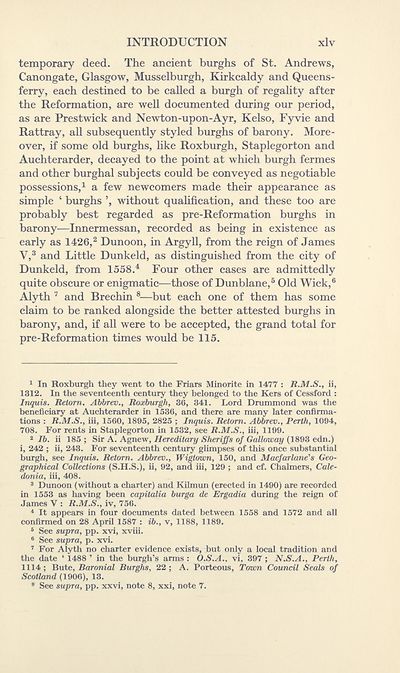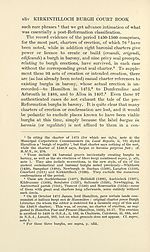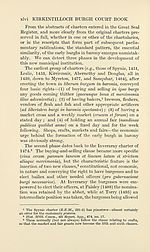Series 3 > Court book of the Burgh of Kirkintilloch 1658-1694
(52) Page xlv
Download files
Complete book:
Individual page:
Thumbnail gallery: Grid view | List view

INTRODUCTION
xlv
temporary deed. The ancient burghs of St. Andrews,
Canongate, Glasgow, Musselburgh, Kirkcaldy and Queens-
ferry, each destined to be called a burgh of regality after
the Reformation, are well documented during our period,
as are Prestwick and Newton-upon-Ayr, Kelso, Fyvie and
Rattray, all subsequently styled burghs of barony. More¬
over, if some old burghs, like Roxburgh, Staplegorton and
Auchterarder, decayed to the point at which burgh fermes
and other burghal subjects could be conveyed as negotiable
possessions,1 a few newcomers made their appearance as
simple ‘ burghs ’, without qualification, and these too are
probably best regarded as pre-Reformation burghs in
barony—Innermessan, recorded as being in existence as
early as 1426,2 Dunoon, in Argyll, from the reign of James
V,3 and Little Dunkeld, as distinguished from the city of
Dunkeld, from 1558.4 Four other cases are admittedly
quite obscure or enigmatic—those of Dunblane,5 Old Wick,6
Alyth 7 and Brechin 8—but each one of them has some
claim to be ranked alongside the better attested burghs in
barony, and, if all were to be accepted, the grand total for
pre-Reformation times would be 115.
1 In Roxburgh they went to the Friars Minorite in 1477 : R.M.S., ii,
1312. In the seventeenth century they belonged to the Kers of Cessford :
Inquis. Retorn. Abbrev., Roxburgh, 36, 341. Lord Drummond was the
beneficiary at Auchterarder in 1536, and there are many later confirma¬
tions : R.M.S., iii, 1560, 1895, 2825 ; Inquis. Retorn. Abbrev., Perth, 1094,
708. For rents in Staplegorton in 1532, see R.M.S., iii, 1199.
2 lb. ii 185 ; Sir A. Agnew, Hereditary Sheriffs of Galloway (1893 edn.)
i, 242 ; ii, 243. For seventeenth century glimpses of this once substantial
burgh, see Inquis. Retorn. Abbrev., Wigtown, 150, and Macfarlane's Geo¬
graphical Collections (S.H.S.), ii, 92, and iii, 129 ; and cf. Chalmers, Cale¬
donia, iii, 408.
3 Dunoon (without a charter) and Kilmun (erected in 1490) are recorded
in 1553 as having been capitalia burga de Ergadia during the reign of
James V: R.M.S., iv, 756.
4 It appears in four documents dated between 1558 and 1572 and all
confirmed on 28 April 1587 : ib., v, 1188, 1189.
5 See supra, pp. xvi, xviii.
6 See supra, p. xvi.
7 For Alyth no charter evidence exists, but only a local tradition and
the date ‘ 1488 ’ in the burgh’s arms : O.S.A., vi, 397 ; N.S.A., Perth,
1114; Bute, Baronial Burghs, 22; A. Porteous, Town Council Seals of
Scotland (1906), 13.
8 See supra, pp. xxvi, note 8, xxi, note 7.
xlv
temporary deed. The ancient burghs of St. Andrews,
Canongate, Glasgow, Musselburgh, Kirkcaldy and Queens-
ferry, each destined to be called a burgh of regality after
the Reformation, are well documented during our period,
as are Prestwick and Newton-upon-Ayr, Kelso, Fyvie and
Rattray, all subsequently styled burghs of barony. More¬
over, if some old burghs, like Roxburgh, Staplegorton and
Auchterarder, decayed to the point at which burgh fermes
and other burghal subjects could be conveyed as negotiable
possessions,1 a few newcomers made their appearance as
simple ‘ burghs ’, without qualification, and these too are
probably best regarded as pre-Reformation burghs in
barony—Innermessan, recorded as being in existence as
early as 1426,2 Dunoon, in Argyll, from the reign of James
V,3 and Little Dunkeld, as distinguished from the city of
Dunkeld, from 1558.4 Four other cases are admittedly
quite obscure or enigmatic—those of Dunblane,5 Old Wick,6
Alyth 7 and Brechin 8—but each one of them has some
claim to be ranked alongside the better attested burghs in
barony, and, if all were to be accepted, the grand total for
pre-Reformation times would be 115.
1 In Roxburgh they went to the Friars Minorite in 1477 : R.M.S., ii,
1312. In the seventeenth century they belonged to the Kers of Cessford :
Inquis. Retorn. Abbrev., Roxburgh, 36, 341. Lord Drummond was the
beneficiary at Auchterarder in 1536, and there are many later confirma¬
tions : R.M.S., iii, 1560, 1895, 2825 ; Inquis. Retorn. Abbrev., Perth, 1094,
708. For rents in Staplegorton in 1532, see R.M.S., iii, 1199.
2 lb. ii 185 ; Sir A. Agnew, Hereditary Sheriffs of Galloway (1893 edn.)
i, 242 ; ii, 243. For seventeenth century glimpses of this once substantial
burgh, see Inquis. Retorn. Abbrev., Wigtown, 150, and Macfarlane's Geo¬
graphical Collections (S.H.S.), ii, 92, and iii, 129 ; and cf. Chalmers, Cale¬
donia, iii, 408.
3 Dunoon (without a charter) and Kilmun (erected in 1490) are recorded
in 1553 as having been capitalia burga de Ergadia during the reign of
James V: R.M.S., iv, 756.
4 It appears in four documents dated between 1558 and 1572 and all
confirmed on 28 April 1587 : ib., v, 1188, 1189.
5 See supra, pp. xvi, xviii.
6 See supra, p. xvi.
7 For Alyth no charter evidence exists, but only a local tradition and
the date ‘ 1488 ’ in the burgh’s arms : O.S.A., vi, 397 ; N.S.A., Perth,
1114; Bute, Baronial Burghs, 22; A. Porteous, Town Council Seals of
Scotland (1906), 13.
8 See supra, pp. xxvi, note 8, xxi, note 7.
Set display mode to:
![]() Universal Viewer |
Universal Viewer | ![]() Mirador |
Large image | Transcription
Mirador |
Large image | Transcription
Images and transcriptions on this page, including medium image downloads, may be used under the Creative Commons Attribution 4.0 International Licence unless otherwise stated. ![]()
| Scottish History Society volumes > Series 3 > Court book of the Burgh of Kirkintilloch 1658-1694 > (52) Page xlv |
|---|
| Permanent URL | https://digital.nls.uk/126713787 |
|---|
| Attribution and copyright: |
|
|---|
| Description | Over 180 volumes, published by the Scottish History Society, containing original sources on Scotland's history and people. With a wide range of subjects, the books collectively cover all periods from the 12th to 20th centuries, and reflect changing trends in Scottish history. Sources are accompanied by scholarly interpretation, references and bibliographies. Volumes are usually published annually, and more digitised volumes will be added as they become available. |
|---|


